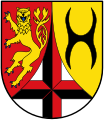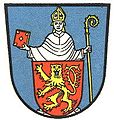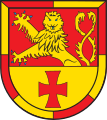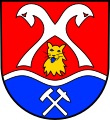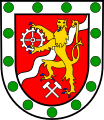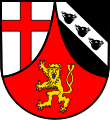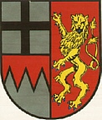County Sayn
|
Territory in the Holy Roman Empire |
|
|---|---|
| County Sayn | |
| coat of arms | |

|
|
| map | |

|
|
| County Sayn (brown) with Wittgenstein (light brown, right) and Herrschaft Homburg (white) in the 15th century | |
| Alternative names | Seyne |
| Form of rule | county |
| Ruler / government | Count |
| Today's region / s | DE-RP |
| Parliament | Reichsfürstenrat : part of a curiate vote of the Westphalian count bank |
| Reich register | 3 horsemen, 13 foot soldiers, 46 guilders |
| Reichskreis | Lower Rhine-Westphalian |
| Capitals / residences | Sayn , Hachenburg , Altenkirchen |
| Dynasties | Sayn 1246: Sponheim 1606: Sayn-Wittgenstein-Sayn |
| Language / n |
German
|
| Incorporated into | 1652: S.-Altenkirchen 1645: S.-Hachenburg
|
The County of Sayn was an imperial territory of the Holy Roman Empire of the German Nation in the area of the Westerwald in today's state of Rhineland-Palatinate .
history
After the castle Sayn near Bendorf , which was probably built in the 10th or 11th century , a dynasty of counts named itself, which is documented for the first time in 1139. The counts gradually acquired goods in the Westerwald , on the Sieg and on the Lower Rhine . The exact origins of the first Counts of Sayn are still unknown, but a descent from the House of Nassau is likely. The County of Sayn is apparently not an old administrative district, but a collection of rights and fiefs of the aristocratic Sayn family. Especially the marriage of Heinrich II. To Agnes von Saffenberg (around 1173) and the marriage of Heinrich III. with Mechthild von Landsberg the family gained considerable possessions. The older line of the Counts of Sayn died in 1246 with the death of Heinrich III. out. His sister Adelheid was with Gottfried III. von Sponheim married and brought the county of Sayn as heir to the Counts of Sponheim. Some possessions then fell to Gottfried's second son Heinrich or to the rule of Heinsberg . The grandson of Gottfried III. through his eldest son Johann I (also named Gottfried) finally founded the younger line of the Counts of Sayn.
At the beginning of the 14th century, under Count Gottfried von Sayn, a targeted Saynian city policy to expand and secure the county of Sayn in the Westerwald can be established.
In 1462 the county was in feud with the County of Katzenelnbogen . As part of the feud, Count Philipp von Katzenelnbogen had several villages and the church of Höhn destroyed.
From 1500 the county of Sayn belonged to the Lower Rhine-Westphalian Empire . Count Adolph and Count Sebastian introduced the Reformation around 1560 .
First Count of Sayn
- Eberhard (1139–1176) ⚭ Kunigunde von Isenburg
- Heinrich II. (1176–1203) ⚭ Agnes von Saffenburg (1173–1200)
- Henry III. (1202–1246) ⚭ Mechthild von Landsberg
- Adelheid von Sayn (1202–1263) ⚭ I Gottfried III. von Sponheim ⚭ II Eberhard von Eberstein the Elder
- Agnes von Sayn (1202–1260) ⚭ Heinrich von Blieskastel
- Eberhard von Sayn (1249–1257), German master
- Eberhard II of Sayn (1176–1202)
- Bruno was Archbishop of Cologne from 1205 to 1208
- Gerlach (1202–1222), provost in Zyfflicher Stift
- Agathe ⚭ Ludwig von Loon ?
- Heinrich II. (1176–1203) ⚭ Agnes von Saffenburg (1173–1200)
- Henry I (1139-1159)
(Source below)
Second Count von Sayn from the House of Sponheim
Count Heinrich III. Sister Adelheid was with Gottfried III. married from Sponheim . Both grandson Gottfried I is the progenitor of a second count family Sayn.
- Adelheid (1247–1263), married to Gottfried III. (Count of Sponheim)
- Johann I (1263–1266), Count of Sponheim, Count of Sayn. Parts of the county ( Löwenburg , Freusburg ) fall to the younger brother Heinrich , heir of Heinsberg .
- Gottfried I. (1266–1284) An inheritance was divided among his sons in 1294:
- Johann II inherited the County of Sayn and founded the line of the Counts of Sayn-Sayn;
- his brother Engelbert I inherited Vallendar and from his maternal inheritance Homburg and founded the line of the Counts of Sayn-Homburg. The Sayn-Homburg family called themselves Sayn-Wittgenstein from 1361 through the inherited county of Wittgenstein in today's Siegen-Wittgenstein district .
Count of Sayn-Sayn
- John II (1284-1324)
- Gottfried II. (1314-1327), co-regent 1314-1324
- Johann III. (1327-1359)
- John IV (1359-1403)
- Gerhard I (1403–1419), his brother Reinhard, was bishop of Kulm from 1385 to 1390
- Theodor (1419-1452)
- Gerhard II (1452-1493)
- Gerhard III. (1493–1506), no male descendants, his brother inherits it
- Johann V. (1498–1529), son of Sebastian I.
- Johann VI. (1529–1560), after his death his brother reigns first
- Sebastian II. (1529–1573), the three sons of Johann VI inherit it.
- Adolph (1560-1568)
- Hermann (1560–1571) and
- Henry IV (1560–1606)
the only heiress is Hermann's daughter
- Anna Elisabeth (1606–1608), married to Count Wilhelm III. from Sayn-Wittgenstein
The Counts of Sayn-Wittgenstein-Sayn
Count Wilhelm III. founded the Sayn-Wittgenstein-Sayn line , to which the West Forest inheritance of the Sayn-Sayn line falls. The ancestral land around Sayn Castle, however, was withdrawn from Kurtrier as a man's fief. The Wilhelm III. established line Sayn-Wittgenstein-Sayn died out again in 1636 with his seven-year-old grandson Ludwig. After Ludwig's death, the line fell to his sisters and their descendants divided it into the counties of Sayn-Hachenburg and Sayn-Altenkirchen.
- William III. (ruled 1605–1623)
- Ernst (ruled 1623–1632), son of Wilhelm III. and Anna Elisabeth von Sayn, ⚭ 1624 Louise Juliane von Erbach (1603–1670)
- Ludwig (ruled 1632–1636 under the tutelage of his mother Louise Juliane), son of Ernst
The counties Sayn-Hachenburg and Sayn-Altenkirchen
After Count Ludwig dies without male descendants, the county is divided between his sisters Johannette and Ernestine.
- Johannette, married in second marriage to Duke Johann Georg von Sachsen , received the office of Altenkirchen . This resulted in the → County of Sayn-Altenkirchen .
- Ernestine, married to Salentin Ernst von Manderscheid , received the → County of Sayn-Hachenburg .
Sayn-Hachenburg fell to the Prince of Nassau-Weilburg in 1799 ; Sayn-Altenkirchen came into Prussian possession in 1791 and was awarded to the Prince of Nassau-Usingen at the Reichsdeputationshauptschluss in 1803 . In connection with the formation of the Rhine Confederation , the two Nassau principalities and thus the two Saynian counties were merged to form the Duchy of Nassau in 1806 . Due to the resolutions at the Congress of Vienna (1815), the division was again divided. The parts of the two former Saynian counties that were in today's Altenkirchen (Westerwald) district were ceded by Nassau to the Kingdom of Prussia and the parts of the former Sayn-Hachenburg that were in today's Westerwaldkreis remained with Nassau until they were also part of Prussia in 1866 came.
The counties were treated as independent dominions until the end of the Old Kingdom in 1806 and administered remotely. Duke Adolf I of Nassau became Grand Duke of Luxembourg in 1890. Since then, the title of Count von Sayn has been borne by the Grand Dukes of Luxembourg.
territory
The county of Sayn was in what is now the state of Rhineland-Palatinate . The ancestral land lost in 1605 was on the right Middle Rhine around Sayn Castle , now part of the city of Bendorf . The much larger territories were in the northern Westerwald and in the central Siegtal . Neighboring gentlemen were:
- in the north the Duchy of Berg and the Lordship of Wildenburg ( Wildenburger Land ),
- in the east Nassau-Dillenburg ,
- in the south the county of Wied ,
- in the south of the exclave of Bendorf, the Electorate of Trier ,
- in the north of the exclave of Bendorf, the county of Isenburg
- in the west Kurköln .
Former Sayn Premonstratensian Abbey , house monastery and burial place
Hachenburg Castle
coat of arms
The county of Sayn and the first house of Sayn had the following family coat of arms : In red a golden, looking lion ( Gelöwter Leopard ), armed and tongued in blue, tail split. On the helmet with red and gold covers a growing golden ram's horn . It appears in a number of county and municipal coats of arms, for example:
Oberwesterwaldkreis (1867–1974)
The Sayner lion in the coat of arms of Adolf von Nassau-Weilburg, Grand Duke of Luxembourg, Duke of Nassau (bottom row, 2nd from left)
See also
literature
- Johann Jacob Moser : State law of the Reichs-Grafschektiven Sayn. 1749 ( dilibri Rhineland-Palatinate )
- Matthias Dahlhoff: History of the county of Sayn and the components of the same. Dillenburg 1874 ( Google Books ).
- Hellmuth Gensicke : State history of the Westerwald. 3rd edition, Historical Commission for Nassau, Wiesbaden 1999, ISBN 3-922244-80-7 .
- Joachim J. Halbekann: The older counts of Sayn. Historical Commission for Nassau, Wiesbaden 1997, ISBN 3-930221-01-2 .
- Köbler: Historical lexicon of the German states. 6th edition, Munich 1999.
- Markus Müller: Municipalities and State in the Reichsgrafschaft Sayn-Hachenburg 1652–1799 (= contributions to the history of Nassau and the State of Hesse. Volume 3). Historical Commission for Nassau, Wiesbaden 2005, ISBN 3-930221-14-4 .
- Daniel Schneider: The development of denominations in the county of Sayn in the plan. In: Heimat-Jahrbuch des Kreis Altenkirchen. Volume 58, 2015, pp. 74–80.
- Daniel Schneider: The estates in the county of Sayn as well as in Sayn-Altenkirchen and Sayn-Hachenburg. In: Yearbook for West German State History. 33rd volume, 2007, pp. 213-229.
- Daniel Schneider: The urban policy of the Counts of Sayn in the late Middle Ages. In: Yearbook for West German State History. Volume 41, 2015, pp. 33–49.
- Genealogical manual of the nobility . Nobility Lexicon. Volume XII, volume 125 of the complete series, pp. 281-285, CA Starke Verlag, Limburg (Lahn) 2001, ISSN 0435-2408 .
Web links
- Document registers from the archive of the Sayn-Wittgenstein branch in Berleburg Castle / digital Westphalian document database (DWUD)
- Genealogy of the second house Sayn at genealogy.eu (English)
- Genealogy of the line Sayn-Wittgenstein-Sayn at genealogy.eu (English)
Individual evidence
- ^ Cf. Daniel Schneider: The urban policy of the Counts of Sayn in the late Middle Ages. Pp. 33-49.
- ^ Karl Kessler, Wolfgang Reinhardt: Great Westerwaldführer . Ed .: Hermann-Josef Hucke [editor]. 3. Edition. Westerwald-Verein e. V., Montabaur 1991, ISBN 3-921548-04-7 , p. 108-109 .
- ↑ On denominational development cf. Daniel Schneider: The development of denominations in the county of Sayn in the plan. Pp. 74-80.
- ↑ Joachim Half Can: The older Counts of Sayn
- ↑ November 2, 1208. Death of Bruno IV von Sayn, Archbishop of Cologne. ( Memento of the original from March 17, 2014 in the Internet Archive ) Info: The archive link was inserted automatically and has not yet been checked. Please check the original and archive link according to the instructions and then remove this notice. at the State Main Archives Koblenz.





